Screening of salt-tolerance potential of some native forage grasses from the eastern part of Terai-Duar grasslands in India
DOI:
https://doi.org/10.17138/tgft(5)129-142Abstract
The salt tolerance of 12 native forage grasses from the eastern part of Terai-Duar grasslands was assessed using a rapid method of leaf disc senescence bioassay. Samples of these grasses were grown in untreated water as well as 100 and 200 mM NaCl solutions for periods of 3, 6 and 9 days. Discs of fresh leaf were then placed in untreated water as well as in 100 and 200 mM NaCl solutions for 96 hours. Quantitative effects were measured as the effects on chlorophyll concentration in leaves in response to exposure to the varying solutions. From these results, the salt sensitivity index (SSI) of the individual grasses was determined. The SSI values indicated that Imperata cylindrica, Digitaria ciliaris and Cynodon dactylon were most salt-tolerant of all grasses tested. Further characterization of the grasses was done by observing the changes in 6 biomarkers for salinity tolerance: relative water content, total sugar concentration, proline concentration, electrolyte leakage, membrane lipid peroxidation and H2O2 concentration following exposure to 100 and 200 mM NaCl concentrations for 3, 6 and 9 days. Finally, hierarchical cluster analysis using the software CLUSTER 3.0 was used to represent the inter-relations among the physiological parameters and to group the grasses on the basis of their salinity tolerance. The overall results indicated that Imperata cylindrica, Eragrostis amabilis, Cynodon dactylon and Digitaria ciliaris were potentially salt-tolerant grasses and should be planted on saline areas to verify our results. On the other hand, Axonopus compressus, Chrysopogon aciculatus, Oplismenus burmanni and Thysanolaena latifolia were found to be highly salt-sensitive and would be unsuitable for use in saline areas.




